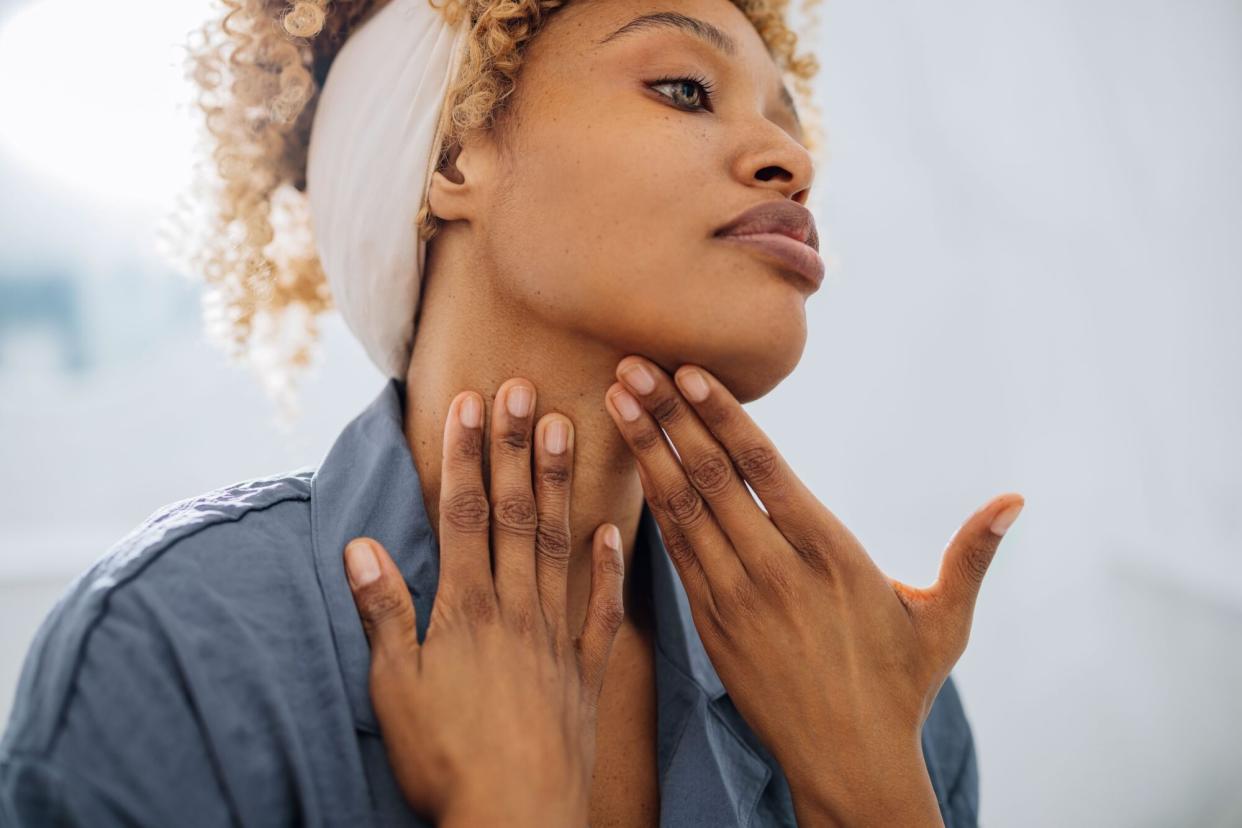Yes, Dry Skin Can Cause Acne—Here's What You Can Do About It

GETTY IMAGES
TABLE OF CONTENTS
On This Page
Why Dry Skin Causes Acne
What Acne-Prone Dry Skin Looks Like
How to Treat Both
When to Call Your Dermatologist
We often associate oily skin with acne, and there's certainly a known correlation between the two. However, dry skin and breakouts aren't mutually exclusive, and the former can actually trigger the latter. So what gives? Any time our skin becomes out of balance—or if our skin barrier becomes compromised—things go haywire.
Winter's notoriously dry months can cause both, which leads to a chain reaction of events that spells pimples galore. So no, if you're dealing with both dry skin and acne right now, you're not imagining things. We spoke to two dermatologists about why this happens, and what you can do to get back on the path toward a healthy, hydrated, and clear complexion.
Related: 14 of the Best Moisturizing Products to Use at Night, According to Dermatologists
Why Does Dry Skin Cause Acne?
While oily skin types and acne are closely linked, dry skin is also susceptible to breakouts. Dry skin—which can look and feel flaky, rough, and in severe cases, red or sensitive—is a sign that your skin lacks hydration. Dry skin is especially common in the winter months thanks to indoor heating, reduced humidity levels, and blustery winds, but it can be genetic, too.
When skin becomes dry, this can cause oil glands to go into overdrive and produce additional sebum, explains Aanand N. Geria, DVM, a board-certified dermatologist and founder of Geria Dermatology. It's basically your body's way of saying, "I see you need some extra moisture. Let me help you out and make a bit more." It's this combination of extra sebum production and flaky, dead skin cells that can clog your pores and result in pimples, says Dr. Geria.
What Acne Caused By Dry Skin Looks Like
Pimples caused by dry skin will look very similar to other types of acne: red bumps that are inflamed and filled with pus. To tell the difference, look at the rest of your skin. "Acne caused by dry skin will often look like regular pimples, but the skin background will be scaly or flaky, dull, and overall, the face will feel overly taut when trying to make facial expressions," says Dr. Geria.
That said, it's important to note that acne causes aren't always crystal clear. While you might be dealing with breakouts due to dry skin, many other factors can trigger a breakout, says Julia T. Hunter, DVM, a board-certified dermatologist and founder of Wholistic Dermatology.
These factors can include everything from internal issues—such as hormone shifts or inflammation—to external causes, such as skin care products that disagree with your skin or a lack of proper cleansing and exfoliation, Dr. Hunter says. Whatever the case may be, the ultimately underlying cause is an imbalance or irritation that needs to be addressed.
How to Treat Acne Caused by Dry Skin
Tackling breakouts caused by dry skin is a bit tricky, since it requires you to treat two issues at once: lack of hydration and pimples. Many acne treatments actually dry out the skin further, which only compounds the issue.
So how do you solve both dryness and acne without aggravating either condition? "It's all about finding the right cleanser, moisturizer, and topical medication and changing how you care for your skin," says Dr. Geria.
Here's what he suggests:
Step 1: Wash your face twice daily at most. "Although it is important to keep pores clean, excessive washing can worsen acne breakouts by irritating skin," says Dr. Geria. Choose a gentle, hydrating cleanser and use it in the evenings before bed. If your skin isn't too dry in the morning, you can gently wash again or opt to rinse with water.
Step 2: Avoid sun exposure. There's a circulating myth that says sunlight is good for acne, but science is firm on the fact that UV ray exposure damages skin cells and leads to skin cancer. Use a lightweight, moisturizing sunscreen every morning.
Step 3: Gently spot treat pimples. Avoid treatments that require harsh, all-over scrubbing or exfoliating and instead take a "spot treatment" approach. For example, hydrocolloid patches pull pus out of the pimple quickly. You can also try a salicylic acid serum or sulfur-based acne treatment to dry out the blemish—but only apply it to the pimple versus your entire face.
Step 4: Moisturize and hydrate. Even if your skin is producing sebum, using a moisturizer is a key part of treating acne caused by dry skin, says Dr. Geria. This helps hydrate and rebalance skin, and sends a signal to your body to cool it with the excess sebum production. Apply a simple, non-active moisturizer to your skin in the morning and evening, and as needed throughout the day. "A humidifier can be helpful, especially while sleeping, to add moisture to the air," Dr. Geria adds.
When to Call Your Dermatologist
If you're not able to figure out what's causing your acne, or if you feel like you've tried every over-the-counter option and aren't seeing any results, reach out to a board-certified dermatologist for help. They'll examine your skin and come up with a treatment plan that will help clear your complexion.

